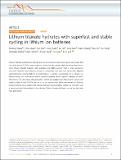| dc.contributor.author | Wang, Shitong | |
| dc.contributor.author | Quan, Wei | |
| dc.contributor.author | Zhu, Zhi | |
| dc.contributor.author | Yang, Yong | |
| dc.contributor.author | Liu, Qi | |
| dc.contributor.author | Ren, Yang | |
| dc.contributor.author | Zhang, Xiaoyi | |
| dc.contributor.author | Xu, Rui | |
| dc.contributor.author | Hong, Ye | |
| dc.contributor.author | Zhang, Zhongtai | |
| dc.contributor.author | Amine, Khalil | |
| dc.contributor.author | Tang, Zilong | |
| dc.contributor.author | Lu, Jun | |
| dc.contributor.author | Li, Ju | |
| dc.date.accessioned | 2017-12-12T16:40:41Z | |
| dc.date.available | 2017-12-12T16:40:41Z | |
| dc.date.issued | 2017-09 | |
| dc.date.submitted | 2016-11 | |
| dc.identifier.issn | 2041-1723 | |
| dc.identifier.uri | http://hdl.handle.net/1721.1/112716 | |
| dc.description.abstract | Lithium titanate and titanium dioxide are two best-known high-performance electrodes that can cycle around 10,000 times in aprotic lithium ion electrolytes. Here we show there exists more lithium titanate hydrates with superfast and stable cycling. That is, water promotes structural diversity and nanostructuring of compounds, but does not necessarily degrade electrochemical cycling stability or performance in aprotic electrolytes. As a lithium ion battery anode, our multi-phase lithium titanate hydrates show a specific capacity of about 130 mA h g⁻¹ at ∼35 C (fully charged within ∼100 s) and sustain more than 10,000 cycles with capacity fade of only 0.001% per cycle. In situ synchrotron diffraction reveals no 2-phase transformations, but a single solid-solution behavior during battery cycling. So instead of just a nanostructured intermediate to be calcined, lithium titanate hydrates can be the desirable final destination. | en_US |
| dc.description.sponsorship | United States. Department of Energy (Contract DE-AC0206CH11357) | en_US |
| dc.publisher | Nature Publishing Group | en_US |
| dc.relation.isversionof | http://dx.doi.org/10.1038/s41467-017-00574-9 | en_US |
| dc.rights | Creative Commons Attribution 4.0 International | en_US |
| dc.rights.uri | https://creativecommons.org/licenses/by/4.0/ | en_US |
| dc.source | Nature | en_US |
| dc.title | Lithium titanate hydrates with superfast and stable cycling in lithium ion batteries | en_US |
| dc.type | Article | en_US |
| dc.identifier.citation | Wang, Shitong et al. “Lithium Titanate Hydrates with Superfast and Stable Cycling in Lithium Ion Batteries.” Nature Communications 8, 1 (September 2017): 627 © 2017 The Author(s) | en_US |
| dc.contributor.department | Massachusetts Institute of Technology. Department of Materials Science and Engineering | en_US |
| dc.contributor.department | Massachusetts Institute of Technology. Department of Nuclear Science and Engineering | en_US |
| dc.contributor.mitauthor | Wang, Shitong | |
| dc.contributor.mitauthor | Zhu, Zhi | |
| dc.contributor.mitauthor | Li, Ju | |
| dc.relation.journal | Nature Communications | en_US |
| dc.eprint.version | Final published version | en_US |
| dc.type.uri | http://purl.org/eprint/type/JournalArticle | en_US |
| eprint.status | http://purl.org/eprint/status/PeerReviewed | en_US |
| dc.date.updated | 2017-12-11T19:51:12Z | |
| dspace.orderedauthors | Wang, Shitong; Quan, Wei; Zhu, Zhi; Yang, Yong; Liu, Qi; Ren, Yang; Zhang, Xiaoyi; Xu, Rui; Hong, Ye; Zhang, Zhongtai; Amine, Khalil; Tang, Zilong; Lu, Jun; Li, Ju | en_US |
| dspace.embargo.terms | N | en_US |
| dc.identifier.orcid | https://orcid.org/0000-0001-7022-5561 | |
| dc.identifier.orcid | https://orcid.org/0000-0002-7841-8058 | |
| mit.license | PUBLISHER_CC | en_US |
